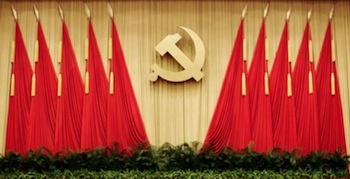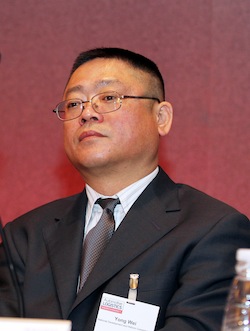The outline of the Chinese government’s reforms following its third plenum congress could have a significant impact on the automotive logistics sector. We analyse the changes proposed to finance, investment, commodity prices and state-owned enterprises

Although the automotive sector was not mentioned specifically in the document, representatives from government and industry say that the reforms will be important to logistics and the automotive supply chain. “The third plenum changes will absolutely have a big impact on automotive logistics, with the market playing a more decisive role and the government standing more behind the stage,” says Wei Yong, chief of the transport and logistics division at the National Development and Reform Commission (NDRC), a planning agency that has broad powers in the economy. He tells Automotive Logistics that the government has to give away more power to both state-owned enterprises and private companies, while playing more of a regulatory role itself.
Cai Jin, vice-president of the government association China Federation of Logistics Purchasing (CFLP), agrees that many of the announced changes will be significant, although he cautions that details still need to be confirmed. “Logistics will have to adjust to the market changes and the new economic growth model,” he says.
Both Cai and Wei’s comments refer specifically to the language used in the third plenum announcement, in which the market, compared to the state, is now said to play a ‘decisive’ role rather than a ‘basic’ one in China’s economy. While the difference might appear semantic, in China many business leaders say this shift will lead to a significant change, or that it reflects what is already a more open atmosphere across the country's business landscape.
Besides the symbolic phrases, there are a number of issues raised among the 60 bullet points in the document (cryptically titled ‘The Decision on Major Issues Concerning Comprehensively Deepening Reform’ – read an abridged version in English here) that could be significant for logistics. The areas mentioned include market reform of energy and transport prices, a loosening of finance, interest rates and currency exchange, wider investment in the e-commerce market, as well as efforts to curb bureaucracy and corruption, particularly among state-owned enterprises (SOEs). There were also points raised about opening up inland border points and cargo routes, which could have implications for export flows.
Although the press has focused more on a number of social changes, including the loosening of China’s notorious one-child policy, reform of its Hukou internal migration restrictions, and the abolition of forced labour camps (the laojiao), many in China were already expecting these changes after announcements this year by Xi Jinping, China’s new president. A number of the proposed economic changes, if implemented, could prove even more daring, as they threaten many special interests in the country.

Cai Jin, speaking during the CFLP conference last week in Xiamen City, warned that such reforms should be gradual and implemented carefully, lest they do too much immediate damage to current businesses. “If you want to raise the price of gas and water, you have to first ask whether it will be bearable for industry? There is a lot of risk and difficulty in reform, and it cannot happen overnight.”
The government has also suggested it would loosen controls on financing and interest rates, which could open the way for easier lending terms for small or medium-sized companies, including foreign or private suppliers or logistics providers. Many such companies, according to industry sources, struggle to get credit and invest. On the other hand, any liberalisation of interest rates would also mean that they would rise for riskier, weaker companies – and potentially for certain state-owned companies.
Efforts to reform bureaucracy and corruption within state agencies could have a notably positive effect. For example, the government has claimed that it will reform its approvals process, which would include giving the go-ahead faster for investment in facilities or granting market access. The central and provincial governments in China play a very large role in granting land and development, and tend to give benefits and incentives to state or municipal-owned companies. According to a source at a major joint venture carmaker in China, gaining approvals from officials in China can be very costly and time consuming, especially for smaller, non-state owned companies.
“It’s particularly difficult for small-and-medium-sized suppliers and 3PLs to gain approvals or comply with all the regulations, and this change could really help them compete in the automotive logistics market,” says the executive, who asked to remain anonymous since he is expressing his personal views.
The document also specified trade, logistics and e-commerce as areas in which China would widen access to investment. This could pave the way for more private and
foreign logistics providers to invest in equipment and operate in the domestic market.
“State-owned enterprises will have more freedom to interact and invest, including in the international automotive and logistics markets,” says Wei. “It’s the same for private companies, which until now have faced more restrictions – they will be freer to do business.”
The third plenum paper outlines several other specific areas of focus in logistics, including the construction of a number of free trade zones based on a trial in Shanghai, as well as reforms in customs supervision and the management of quarantines. It also asserts that industrial clusters and inland cities would be encouraged to setup passenger and cargo air routes, as well as to develop multimodal transport. There were few details on how these developments would proceed, however.
Namrita Chow, manager at senior analyst at IHS Automotive, a consultancy, pointed out that the mention of opening up inland border points could pave the way for overland exports to neighbouring countries. "It could lead to more exports by rail or road to markets like Kazakhstan and Burma," she tells Automotive Logistics.
Opening up e-commerce
Several observers, including Cai and Wei, note that the opening up of the e-commerce market will be important for both the general logistics and automotive logistics sector. While details on the reforms for e-commerce are currently limited, according to Wei there could be changes in the tax structure for online shopping.

For automotive, e-commerce already has potential to grow for spare part orders as well as vehicle deliveries, particularly for used vehicles. According to Bill Wang, investment director for Beijing Changjiu Logistics, one of China’s largest private logistics firms, the company has set up a department to handle second-hand vehicle sales online.
“Customers order the car and pay for it online, and the price includes the logistics,” he says. “We then combine the second-hand volume with our new vehicles for delivery.”
An area where many observers have hoped to see reform is among state-owned enterprises (SOEs), which are ubiquitous in China across manufacturing, utilities, transport and services. In many sectors SOEs have been considered a drain on public resources and capital in China, drawing huge public investment and incentives to add capacity, fund salaries and pensions, while paying less than private companies in taxes. Many are also considered to be inefficient and lag foreign or private competitors in technology.
The government called for both vague and specific change for SOEs, although such companies were enshrined in the document as still playing a major role in China’s economy. However, there are to be improvements in SOE management and oversight, as well as a crackdown on corruption and cronyism.
More specifically, the government wants to see the public share more in the profits of such companies, including plans to transfer some SOE funds to social security programmes and for 30% of their capital gains to go toward the public purse.
So is the Chinese automotive industry, which is overgrown with dozens of car and truck manufacturers owned by various state and municipal bodies, about to be trimmed by reform? For nearly a decade Chinese officials have said that they would consolidate the automotive industry to a handful of strong, local players. The cull has not really happened, or has barely skimmed the top so far. However, Chow says that the government has recently published a list of more than 40 OEMs, which have until 2015 to justify their production capacity or else they could lose their licences.
Meanwhile, large joint ventures between state-owned companies and foreign carmakers have thrived, including SAIC with Volkswagen and General Motors, FAW with Volkswagen and Toyota, Ford and PSA with Changan, Nissan and PSA with Dongfeng, and many others. Wang Zeng, senior analyst for China vehicle sales at IHS Automotive, does not expect that the government will move quickly to change or reform these companies. "While the government plays a role and provides incentives, it actually doesn't get too involved in running these joint ventures," he says.
Most of these companies have built modern factories with good environmental ratings and high levels of efficient. Almost all of these OEMs are opening new plants over the next two to three years. Three of them – SVW, SGM and FAW-GM – account for about 30% of the passenger car market.
In the plenum paper, the government endorsed more ‘mixed ownership’ of companies, which is perhaps a nod to the success of such joint ventures. Indeed, just a few days after the announcements, Daimler bought a 12% stake in its local Chinese partner, BAIC. However, despite the promise of more open investment, Wang also doubts that the government would allow a large scale privatisation or foreign investment in the state-owned brands.
State-owned Chinese automotive brands also tend to retain in-house logistics providers to serve their factories (some in joint ventures with global 3PLs). Executives acknowledge these companies do have some gaps in expertise, equipment and technology. The in-house model also leads to some political sensitivities in the autmotive logistics market. Managers from Beijing Changjiu Logistics, for example, point out that because some OEMs are tied to in-house providers for particular plants, which means transport networks are not as efficiently run as they might be under independent 3PLs.
“Some OEMs will think twice before awarding services to other providers since it would be too politically sensitive not to work with the provider,” says Mark Ding, regional marketing director.
However, the automotive logistics sector too has seen operational benefits from the joint-venture model, and the logistics processes for these plants and providers are also quite sophisticated, including a high level of value-added services. For example, Shanghai VW outsourced its in-plant logistics and parts inventory management to Anji Ceva – a joint venture between SAIC’s Anji and Ceva Logistics – almost a decade ago. The carmaker has recently been bringing more advanced consolidation and material handling processes to its newest plants, working with Anji and others.
"There is more collaboration of upstream and downstream companies. Optimisation has changed from vertical integration to horizontal logistics" - Yu De, Anji Automotive
Ford, meanwhile, has been working with Changan’s in-house provider, CMAL, to help it to play more of a ‘lead logistics provider’ role, similar to how the carmaker works with Penske in the US or DHL in Europe. Indeed, companies like SVW, FAW-VW and Changan Ford, are all adding production capacity at a rate that may be faster than their in-house providers can keep up, which has lead both to an increase in the joint venture's own logistics competence, as well as using other logisics providers. Beijing Changjiu Logistics has itself worked as a sub-contractor to a number of major in-house providers.
Yu De, managing director of Anji Automotive (which focuses mainly on outbound, while the Anji-Ceva joint venture is stronger for inbound) said at the recent CFLP conference that the automotive logistics value chain was being extended, including more collaboration and supply chain IT. "There is more collaboration of upstream and downstream companies," he said, referring to relations between carmakers and logistics providers. "Optimisation has changed from vertical integration to horizontal logistics."
Given automotive logistics relatively advanced level compared to the general logistics market – which is highly fractured in China, with an estimated 700,000 companies – some feel that automotive and automotive logistics will see fewer changes from reforms to SOEs than will other sectors. “The automobile industry already has full competency in China and you won’t see too much change, especially compared to other SOEs,” says a logistics manager from a major joint venture OEM, who asked to remain anonymous.
Others believe that automotive logistics has the chance to lead reforms in some areas. Speakers at the CFLP conference referred to automotive logistics being at “the pyramid” of the industry, with a chance to become a model across the economy. CFLP’s Cai Jin tells Automotive Logistics that the industry should take a lead, including in developing more ecological processes and advanced technology. “We have to improve technology, lower costs for manufacturers and increase multimodal transport,” he says.
Putting theory to practice
Of course, the changes outlined so far for China are part of a ‘blueprint’ rather than a specific legal framework. Semantics are important, but some passages in the release may end up just being inconsequential. China has been discussing a new ‘economic model’ in its past two sets of five-year plans, including a shift towards service, consumption and innovation. The change has been slow, not least in automotive. The new document calls again for an ‘improved market-based exchange rate’ for the renminbi, which has since been backed up China's central bank, but it’s unclear just how much and how fast China will let its currency appreciate.
President Xi is set to lead a small team that will oversee the reforms, which some have taken as a strong signal of action (“...a sign of the central government’s growing economic competence,” according to Cai). But the currency, SOE changes and other reforms could be painful for companies, including in the automotive and logistics sectors. While automotive logistics in China might be advanced, power is still concentrated in a number of mainly state-owned companies, and the opening up of further investment and looser price controls could help modernise the market. Having laid out a new theoretical principle for the market’s role in China, the question now is just how ‘decisive’ the central government will actually be in practice.





































